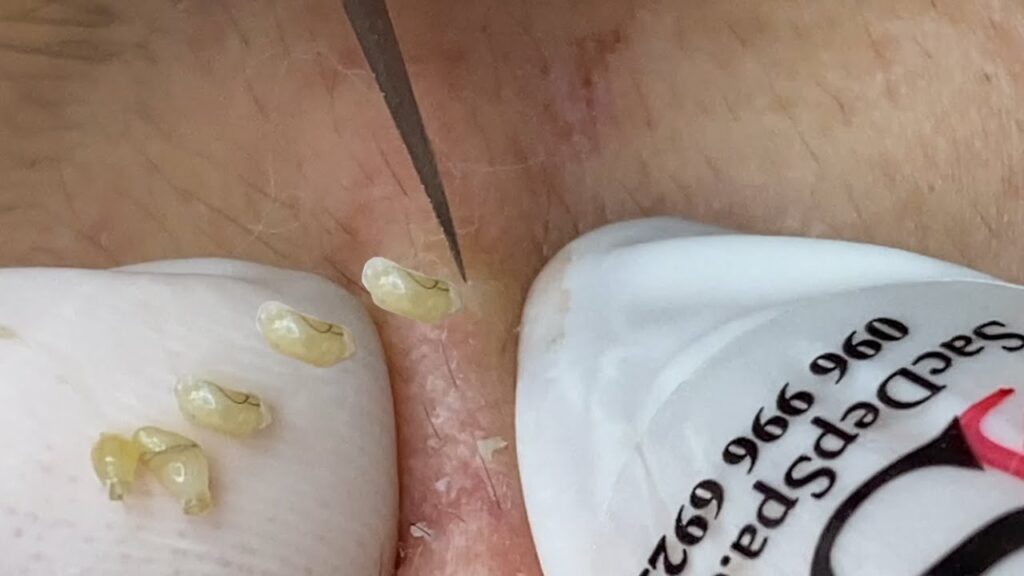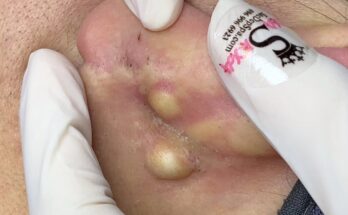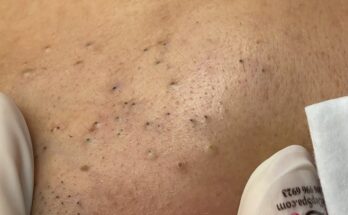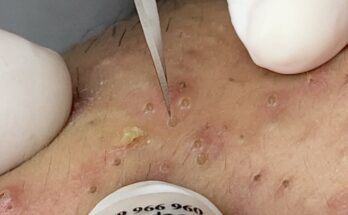Blackhead acne, also known as open comedones, is a common skin condition that occurs when pores become clogged with oil, dead skin cells, and sometimes bacteria. Below, I’ll explain in detail how blackheads form, why they appear on the face, and provide a step-by-step guide to prevent and treat them effectively.

How Blackheads Appear on the Face
Blackheads form due to a combination of factors that affect the skin’s pores, particularly in areas with high oil production, such as the T-zone (forehead, nose, and chin). Here’s a detailed breakdown of the process:
- Excess Sebum Production:
- The skin’s sebaceous glands produce sebum, an oily substance that keeps the skin moisturized.
- Overproduction of sebum, often triggered by hormones (e.g., during puberty, menstruation, or stress), can lead to excess oil in the pores.
- Areas like the nose and forehead have more sebaceous glands, making them prone to blackheads.
- Buildup of Dead Skin Cells:
- The skin naturally sheds dead skin cells, but sometimes these cells don’t slough off properly and accumulate in the pores.
- This buildup mixes with sebum, creating a sticky plug that blocks the pore.
- Oxidation of the Pore Contents:
- When the clogged pore is exposed to air, the mixture of sebum and dead skin cells oxidizes, turning dark or black in color. This is why blackheads have a characteristic dark appearance.
- Unlike whiteheads (closed comedones), blackheads are open to the air, which allows oxidation to occur.
- Contributing Factors:
- Hormonal Changes: Puberty, pregnancy, or hormonal imbalances (e.g., polycystic ovary syndrome) can increase oil production.
- Skincare Products: Using heavy, oil-based products or not cleansing properly can clog pores.
- Environmental Factors: Humidity, pollution, or sweat can contribute to pore clogging.
- Diet and Lifestyle: While not directly proven, diets high in processed foods or dairy may exacerbate acne in some individuals.
- Genetics: If your parents had acne-prone skin, you may be more susceptible to blackheads.
- Common Locations:
- Blackheads most commonly appear in the T-zone because of the higher density of oil glands.
- They can also appear on the cheeks, chin, or other areas with active sebaceous glands.
How to Prevent and Treat Blackheads (Step-by-Step)
Preventing and treating blackheads requires a consistent skincare routine, lifestyle adjustments, and sometimes professional help. Below is a detailed, step-by-step guide:
Step 1: Cleanse Your Skin Properly
- Why: Cleansing removes excess oil, dirt, and impurities that can clog pores.
- How:
- Use a gentle, non-comedogenic (won’t clog pores) cleanser twice daily (morning and night).
- Look for ingredients like salicylic acid (exfoliates inside pores) or benzoyl peroxide (kills bacteria and reduces oil).
- Avoid harsh scrubbing, as it can irritate the skin and worsen acne.
- Example products: Cetaphil Gentle Skin Cleanser, Neutrogena Oil-Free Acne Wash.
- Frequency: Twice daily, especially after sweating or wearing makeup.
- Tip: Use lukewarm water to avoid stripping the skin’s natural oils.
Step 2: Exfoliate Regularly
- Why: Exfoliation removes dead skin cells that can clog pores and contribute to blackheads.
- How:
- Use a chemical exfoliant with salicylic acid (beta-hydroxy acid) or glycolic acid (alpha-hydroxy acid) 2–3 times per week.
- Avoid physical scrubs with harsh granules, as they can cause micro-tears and irritation.
- Example products: Paula’s Choice Skin Perfecting 2% BHA Liquid Exfoliant, The Ordinary Glycolic Acid 7% Toning Solution.
- Frequency: 2–3 times per week, depending on skin sensitivity.
- Tip: Start with once a week to test for irritation, then increase as tolerated.
Step 3: Use Non-Comedogenic Moisturizers
- Why: Moisturizing prevents the skin from overproducing oil to compensate for dryness, which can worsen blackheads.
- How:
- Choose a lightweight, non-comedogenic moisturizer suitable for your skin type (oily, combination, or dry).
- Look for ingredients like hyaluronic acid or niacinamide to hydrate and soothe the skin.
- Example products: CeraVe Daily Moisturizing Lotion, La Roche-Posay Effaclar H Moisturizer.
- Frequency: Apply after cleansing, morning and night.
- Tip: Even oily skin needs hydration to maintain a healthy skin barrier.
Step 4: Incorporate Targeted Treatments
- Why: Specific ingredients can unclog pores and prevent blackhead formation.
- How:
- Use products with retinoids (e.g., adapalene, tretinoin) to increase cell turnover and prevent clogged pores. Start with over-the-counter options like Differin Gel (0.1% adapalene).
- Apply benzoyl peroxide (2.5–5%) to reduce bacteria and oil production.
- Use clay masks (e.g., kaolin or bentonite clay) 1–2 times per week to absorb excess oil and draw out impurities.
- Example products: Differin Gel, Aztec Secret Indian Healing Clay Mask.
- Frequency: Retinoids: 2–3 times per week at night (build up tolerance). Clay masks: 1–2 times per week.
- Tip: Always follow with sunscreen during the day, as retinoids can make skin sun-sensitive.
Step 5: Avoid Touching Your Face
- Why: Touching your face transfers oil, dirt, and bacteria, which can clog pores.
- How:
- Wash your hands before applying skincare products.
- Avoid resting your face on your hands or phone, which can harbor bacteria.
- Cleanse after activities like working out to remove sweat and oil.
Step 6: Use Sunscreen Daily
- Why: Sun exposure can thicken the skin, leading to more clogged pores, and UV damage can worsen acne scars.
- How:
- Choose a non-comedogenic, broad-spectrum SPF 30 or higher.
- Opt for gel-based or lightweight sunscreens for oily skin.
- Example products: EltaMD UV Clear Broad-Spectrum SPF 46, Neutrogena Clear Face SPF 30.
- Frequency: Apply every morning, reapply every 2 hours if exposed to sunlight.
- Tip: Sunscreen is non-negotiable, even on cloudy days.
Step 7: Avoid Pore-Clogging Products
- Why: Heavy or comedogenic products (e.g., certain makeup, oils, or creams) can worsen blackheads.
- How:
- Check product labels for “non-comedogenic” or “oil-free.”
- Avoid coconut oil, heavy foundations, or creamy cleansers if you’re prone to blackheads.
- Remove makeup thoroughly with a double-cleansing method (oil-based cleanser followed by a water-based cleanser).
Step 8: Maintain a Healthy Lifestyle
- Why: Diet, stress, and sleep can influence oil production and skin health.
- How:
- Diet: Limit dairy and high-glycemic foods (e.g., sugary snacks), which may trigger acne in some people. Focus on a balanced diet with fruits, vegetables, and omega-3 fatty acids.
- Hydration: Drink plenty of water to support overall skin health.
- Stress Management: Practice stress-relief techniques like meditation or yoga, as stress can increase cortisol and oil production.
- Sleep: Aim for 7–8 hours of sleep to allow skin repair.
Step 9: Avoid Popping or Squeezing Blackheads
- Why: Squeezing can push debris deeper into the pore, causing inflammation, scarring, or infection.
- How:
- If extraction is needed, visit a dermatologist or esthetician for professional extractions.
- At-home tools like comedone extractors can be used sparingly, but only after cleansing and steaming the face to soften pores. Sterilize tools with alcohol to prevent infection.
- Tip: If you must extract, apply gentle pressure around the blackhead, not directly on it, and stop if it causes pain or bleeding.
Step 10: Seek Professional Help if Needed
- Why: Persistent or severe blackheads may require stronger treatments.
- How:
- Consult a dermatologist for prescription treatments like stronger retinoids (e.g., tretinoin) or chemical peels.
- Consider professional treatments like:
- Chemical Peels: Use acids (e.g., salicylic or glycolic) to exfoliate and unclog pores.
- Microdermabrasion: Exfoliates the skin’s surface to remove dead cells.
- Laser Therapy: Targets oil glands to reduce sebum production.
- Discuss underlying causes like hormonal imbalances if blackheads persist.
Additional Tips
- Consistency is Key: Skincare results take time (6–8 weeks for noticeable changes), so stick to your routine.
- Patch Test New Products: Apply a small amount to a small area to check for irritation before full use.
- Change Pillowcases Regularly: Dirty pillowcases can harbor oil and bacteria, contributing to blackheads.
- Avoid Overwashing: Cleansing more than twice daily can strip the skin and increase oil production.
Common Mistakes to Avoid
- Using harsh, alcohol-based products that dry out the skin excessively.
- Over-exfoliating, which can irritate the skin and worsen acne.
- Ignoring sunscreen, leading to skin damage and clogged pores.
- Using comedogenic products (check ingredient lists for things like isopropyl myristate or cocoa butter).
When to See a Dermatologist
- If blackheads persist despite consistent care for 8–12 weeks.
- If you develop painful, inflamed acne (e.g., cysts or nodules) alongside blackheads.
- If you notice scarring or hyperpigmentation from blackheads.
By following this step-by-step guide, you can effectively manage and prevent blackheads while promoting healthier skin. If you have specific concerns or want recommendations tailored to your skin type, feel free to share more details, and I can refine the advice further!
More detail how to remove blackhead as in video below:


